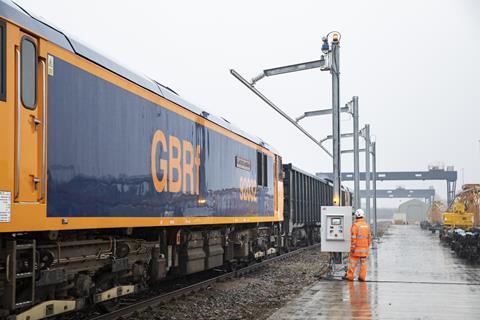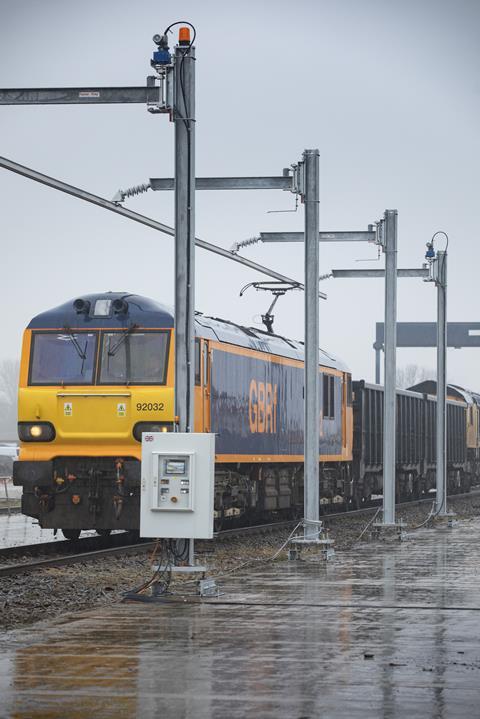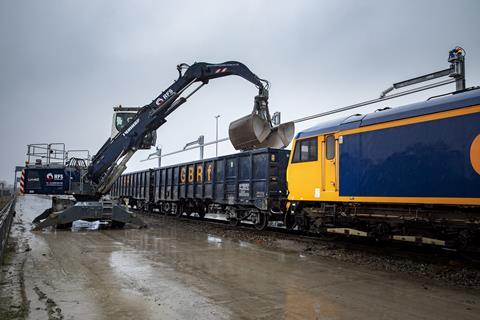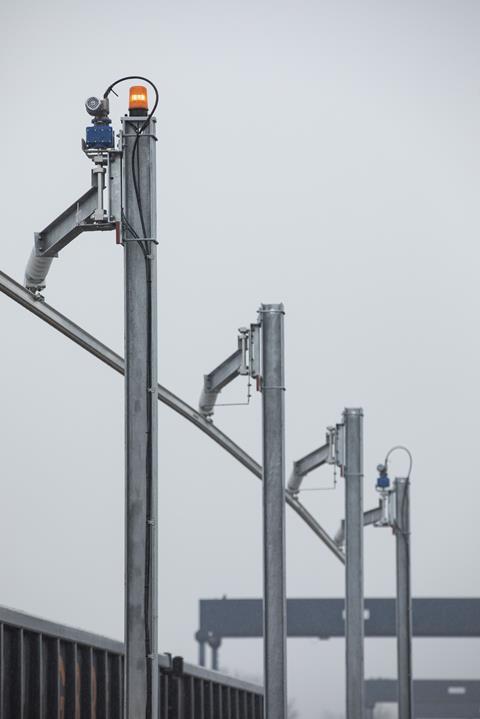
UK: The use of a movable overhead conductor rail to eliminate the need to use diesel locomotives at freight terminals where traditional fixed electrification equipment would obstruct loading and unloading is being demonstrated in the UK, and a trial in India is planned.

The Decarbonisation & Electrification of Freight Terminals project began in 2020 when the Rail Forum Midlands industry association issued a calls for ideas to reduce rail freight emissions.
Swiss electrification equipment specialist Furrer+Frey’s UK business suggested the use of movable 25 kV 50 Hz overhead to eliminate the need for diesel traction at terminals, and after the concept received positive feedback from the wider industry, a successful bid was made for £345 404 of funding under the Department for Transport and Innovate UK’s First of a Kind technology programme.
The DEFT project is being undertaken by Furrer+Frey GB in partnership with operator GB Railfreight and construction materials company Tarmac. Installation at the demonstration site was undertaken by SPL Powerlines.
The movable overhead conductor bar is based on equipment which Furrer+Frey has supplied to around 120 passenger rolling stock depots worldwide, including Eurostar and Agility Trains depots in the UK. This enables electric passenger trains to run into a depot, with the overhead then retracted so that roof-mounted equipment can be safely accessed for maintenance or replacement.
The passenger systems are designed for indoor use, and the freight demonstration equipment had to be adapted for the harsher outdoor environment with exposure to weather and dirt. ‘We needed to take the equipment from indoors to outdoors’, Noel Dolphin, Head of UK projects at Furrer+Frey GB, told Rail Business UK.
Wellingborough and Bhagega

The DEFT demonstration was originally planned for a cement works in Dunbar, but high demand for cement meant the single track at the site could not be taken out of use for installation, and so the trial was moved to Wellingborough where there are multiple tracks and so no impact on regular operations.
The yard is adjacent to the Midland Main Line, which is currently being partly electrified in a scheme which does not cover adjacent freight facilities and will leave ‘islands’ of non-electrified track preventing the end-to-end electric-only operation of freight trains.
The DEFT equipment is not currently connected to the main line electrification, as this would have made the demonstration project significantly more complicated. Dolphin said the current aim is to get government and operators to see that the technology is ready for deployment as and when suitable sites and funding are identified. The payback time on installation is estimated at two to five years, depending how busy a terminal is.
Furrer+Frey is also working with Dedicated Freight Corridor Corp of India on a separate demonstration of the technology at Bhagega Yard near Jaipur.
Hurdle overcome

‘The electrification of freight terminals is the biggest technological hurdle to net zero rail freight and we have just overcome it’, said Dolphin. ‘The demonstrator shows how we can plug freight yards into electrified rail lines and operate them safely and efficiently with the locomotives we already have — meaning greener, cleaner and better journeys.’
GB Railfreight CEO John Smith said DEFT ‘is a great example of what can be achieved when the industry and government work together effectively’. He said rail ‘is already a greener alternative to moving goods by road’ and further electrification would ‘allow us to go even further’ and ‘bolster operations, and the reliability and efficiency of rail freight’.



